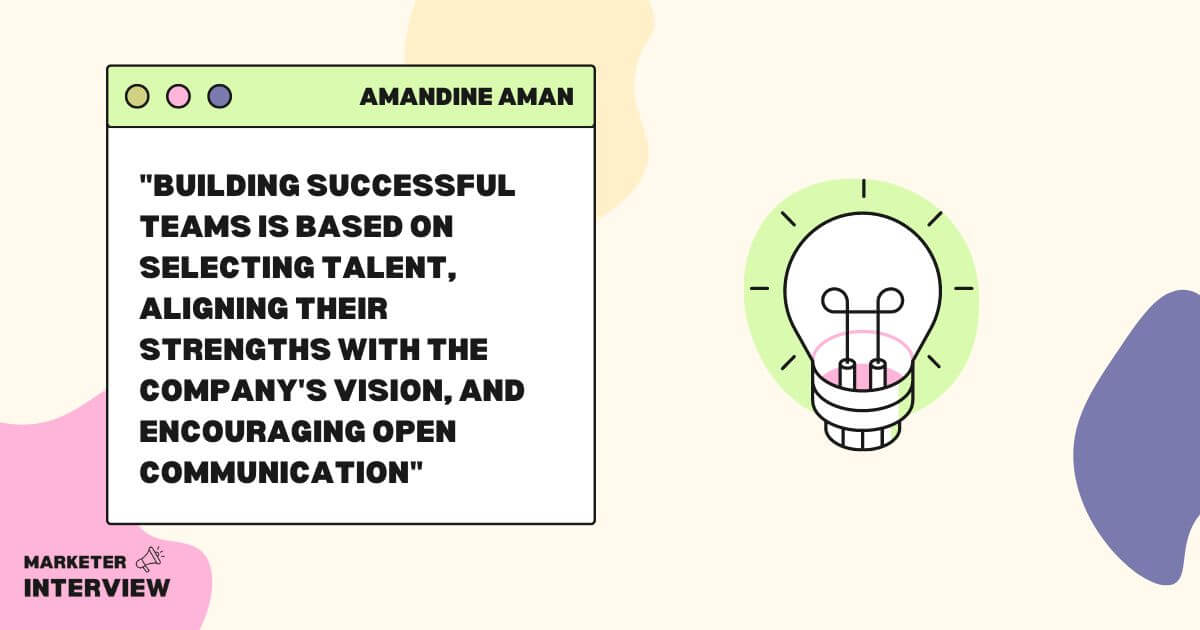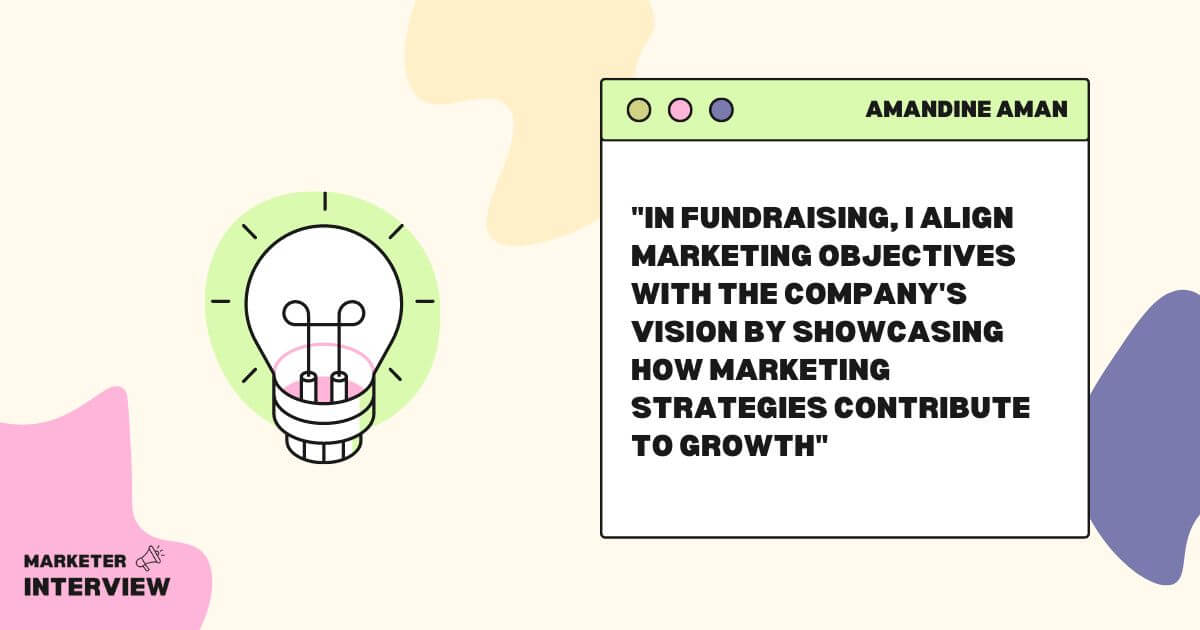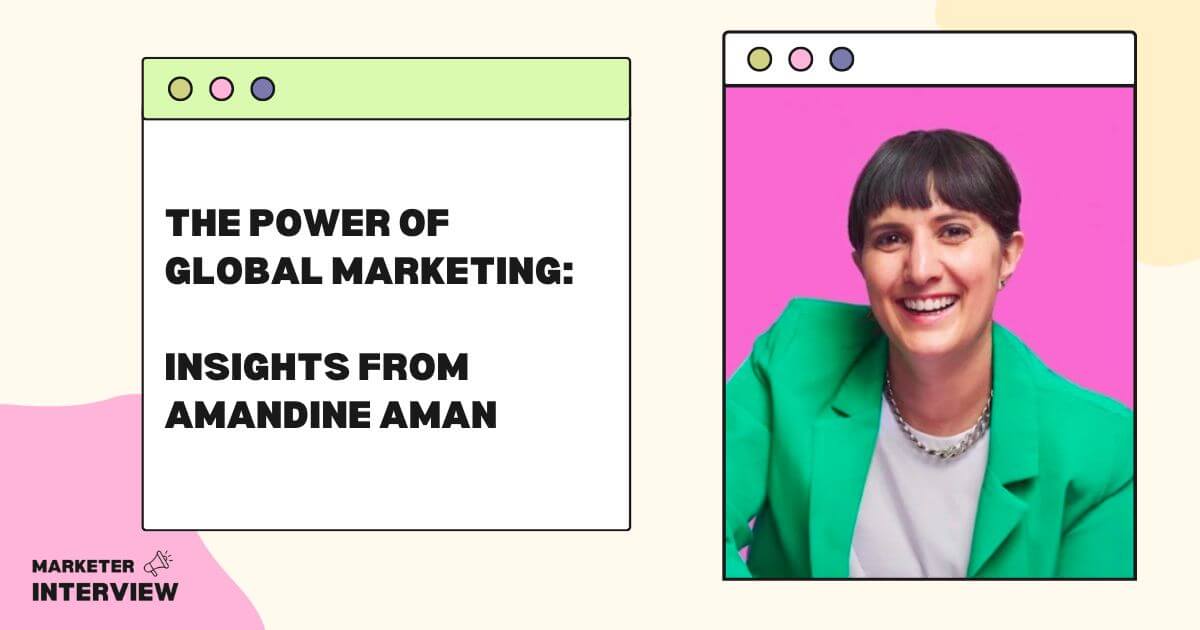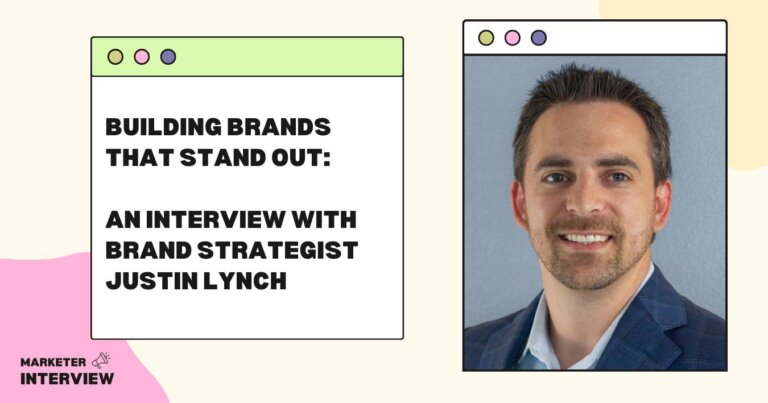The Power of Global Marketing: Insights from Amandine Aman
Welcome to Marketer Interview, where we delve into the minds of extraordinary marketers shaping the industry today.
Today, we have the privilege of speaking with Amandine Aman, the esteemed CMO at Le Wagon, a leading tech Bootcamp.
Amandine’s journey is remarkable, focusing on international expansion and branding and a track record of helping tech companies achieve exponential growth.
Her brand-building and performance marketing expertise sets her apart in the competitive marketing landscape. Let’s explore her insights and learn from her wealth of experience.
Contents
- 1 Could you share your journey into the marketing world and how you discovered your passion for branding and international expansion?
- 2 As a Brand & Marketing advisor, you’ve worked with diverse companies like Le Wagon, Juni Learning, and Luko. How do you approach each project uniquely to meet their growth goals?
- 3 Managing marketing budgets across multiple continents is an impressive feat. Can you tell us about some of the challenges you faced and the strategies you employed to overcome them?
- 4 Building and managing effective marketing teams is crucial for success. What principles do you follow while assembling and nurturing teams in major tech hubs?Building successful teams is based on selecting talent, aligning their strengths with the company’s vision, and encouraging open communication.
- 5 I nurture teams through mentoring, skill development, and promoting an inclusive environment. I focus on nurturing leadership, fostering collaboration, and empowering individuals to take ownership of their roles. I base individual performance on well-defined KPIs.
- 6 Diversity and inclusion (D&I) have become essential for modern organizations. How do you integrate D&I principles into your marketing strategies and team dynamics?
- 7 Fundraising and board meetings are critical aspects of a CMO’s role. Please share some insights on how you approach these responsibilities to align marketing objectives with the broader company vision.
- 8 Performance marketing plays a pivotal role in driving growth. Which platforms and strategies are most effective, and how do you balance performance marketing with a brand-oriented mindset?
- 9 Product and market launches are pivotal moments for companies. What key elements do you prioritize to ensure successful launches and a strong market presence?
- 10 Website launches and content management require meticulous planning. What strategies do you employ to create a compelling online presence and engage your target audience effectively?
- 11 As a leader in managing hyper-growth budgets, please share some tips on optimizing budgets to maximize ROI while maintaining sustainable growth.
- 12 In the ever-evolving landscape of marketing tools and software, which ones have proven indispensable for your role as a CMO, and how do they enhance your marketing efforts?
I embarked on my marketing journey by diving into roles at Mars and McCain Foods, where I honed my skills in brand management and product launches.
These experiences ignited my passion for crafting compelling brand identities and expanding their global reach.
The challenge of coordinating European projects solidified my interest in international expansion, prompting me to join Spreadshirt and, later, Uber. These roles nurtured my passion for strategic marketing and global growth.
As a Brand & Marketing advisor, you’ve worked with diverse companies like Le Wagon, Juni Learning, and Luko. How do you approach each project uniquely to meet their growth goals?
Every company has a unique growth trajectory, so I tailor my approach to their needs.
For instance, I focused on building a robust marketing team to amplify their brand presence and messages at Le Wagon. At Juni Learning, I emphasized partnerships and social media to target Gen Z. Luko demanded scaling European brand awareness, leveraging national TV and OOH campaigns.
My strategies revolve around comprehending the goals, market dynamics, and unique talents and opportunities within each company and market.
Managing marketing budgets across multiple continents is an impressive feat. Can you tell us about some of the challenges you faced and the strategies you employed to overcome them?
Balancing budgets across continents indeed poses challenges but also opportunities. I ensured consistent communication, synchronized strategies, and efficient resource allocation by establishing regional hubs.
I also fostered local market insights and granular reporting to optimize spending. Implementing analytics and tracking enabled real-time adjustments, ensuring ROI across diverse regions – a strong partnership with the CFO, the COO, and the data analytics team is essential. Understanding your performance (at all times) is critical to a significant budget allocation.
Building and managing effective marketing teams is crucial for success. What principles do you follow while assembling and nurturing teams in major tech hubs?
Building successful teams is based on selecting talent, aligning their strengths with the company’s vision, and encouraging open communication.
I nurture teams through mentoring, skill development, and promoting an inclusive environment. I focus on nurturing leadership, fostering collaboration, and empowering individuals to take ownership of their roles. I base individual performance on well-defined KPIs.

Diversity and inclusion (D&I) have become essential for modern organizations. How do you integrate D&I principles into your marketing strategies and team dynamics?
As a minority, I promote inclusivity by being open about my identity and queer culture. As a leader building your team, remember the importance of diversity, as diverse teams perform best and represent our world better.
In terms of brand campaigns, at Uber, we developed an exciting Pride campaign. Our marketing team collaborated with our UberPride ERG (Employee Resource Group), where I was co-chair. The campaign showcased drivers, riders, and employees sharing their distinctive stories.
In fundraising, I align marketing objectives with the company’s vision by showcasing how marketing strategies contribute to growth.
I emphasize metrics such as Revenue, Spend, CAC, ROI, LTV, traffic growth, brand awareness growth, organic growth, and reach. During board meetings, I emphasize data-driven insights to demonstrate the impact of marketing initiatives based on what’s important to our CEO, brand, and investors.
Marketing is bridging the company’s objective and growth – so they must always be aligned. In the context of fundraising, marketing assumes paramount importance as it facilitates the acquisition of data concerning the market, its potential, and customer insights. A comprehensive understanding of your market and a more profound knowledge of your customers are imperative.

Performance marketing plays a pivotal role in driving growth. Which platforms and strategies are most effective, and how do you balance performance marketing with a brand-oriented mindset?
Performance marketing is now like a machine. You need an engineering mindset to make performance marketing work (but it’s not enough). On top of that, advertising platforms and automation tools become intelligent and autonomous (so don’t overbuild your teams).
Creativity is essential to performance marketing. And performance marketing is still marketing. You can be the best at tools and machines but completely miss the point about your customer’s needs.
It’s important to understand everybody’s skills. To me, the balance starts by assembling the right team: some engineer minds, some creative minds – and having them work well together at the service of performance channels. These channels can be TOFU, MOFU, and BOFU actions – you just need to build the audiences the right way and have the right message (more performance-oriented or brand-oriented).
Product and market launches are pivotal moments for companies. What key elements do you prioritize to ensure successful launches and a strong market presence?
Successful product and market launches require a clear value proposition, targeted messaging, and comprehensive customer journeys. They also require the appropriate budget. We’re marketers, not magicians.
I prioritize cross-functional collaboration to ensure alignment between marketing, product, and sales teams. I also ensure we all understand how much money is needed: a soft launch and a real push. Pre-launch engagement, influencer partnerships, PR, and interactive content also contribute to successful launches.
All concerned departments must be all hands on deck. Launching a new product is not only a marketing thing. It’s an Ops thing.
Website launches and content management require meticulous planning. What strategies do you employ to create a compelling online presence and engage your target audience effectively?
I focus on user-centric design, straightforward navigation, and engaging content for website launches. A/B testing and continuous optimization help enhance user experience. You’re on a never-ending quest to make your website the best.
I’ve launched and re-updated 5+ large websites in my life, it’s always a challenge, but it’s so rewarding when they’re live!
Optimizing budgets involves careful analysis of performance data, reallocating resources to high-performing channels, and experimenting with new strategies. It also requires very well-oiled communication between your Ops teams, your Finance team, your agencies, and all parts of your teams.
Ensure you don’t forget about teams other than yours because things go fast, and communication and processes are crucial. A process from 1 month ago might not be what you need today after adding 20 markets or 5 new products led by 5 different business unit leaders.
In the ever-evolving landscape of marketing tools and software, which ones have proven indispensable for your role as a CMO, and how do they enhance your marketing efforts?
It all starts with solid reporting and solid OKRs. Tools like Tableau, Looker, or a good old solid Google Sheet reporting are critical. You don’t need to measure everything. You just need to measure what matters.
My favorite marketing tools are any data reporting tools mentioned earlier, Web analytics / Product analytics tools (GA4, Amplitude, Hotjar..), and brand trackers (can come in many forms but must be there).






